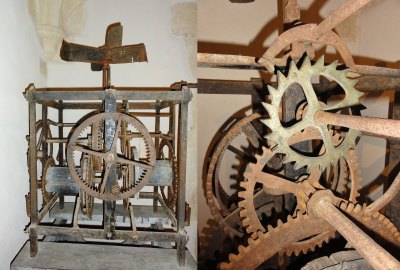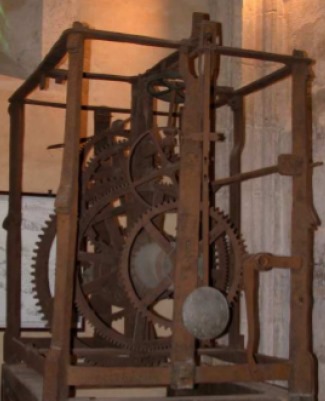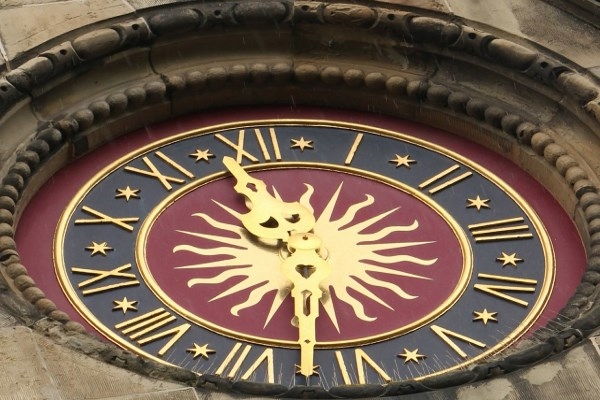How early did Clocks Appear and when was LAT in Effect?
Local apparent time has been in effect since people began to break up the day into sections demarcated by sunrise, noon and sunset. Since the times of sunrise, noon and sunset continuously vary throughout the year at all locations, a time standard tied to any of these events must also be variable. A shadow clock or a sundial is necessarily tied to noon marked by when the Sun’s shadow is shortest or absent altogether for locales in the tropics. After sunset one must know the sky very well to keep track of time by the stars, and in bad weather one must make do with hourglasses or slow-burning fuses or knots which can only offer an approximation of elapsed time, not local apparent time.
Water clocks or klepsydra came into use well before the Christian Era and have the advantage that they can keep time after the Sun has set, but they corrode, they’re messy and they freeze in European winters. Water clocks, since they were kept to local apparent time, were set to noon, usually (sometimes to sunrise or sunset) and adjusted regularly to take into account the changing times of noon which are a consequence of the Sun-Earth geometry. Waterclocks eventually became quite accurate especially within the borders of Islam. They were much more accurate than early mechanical clocks and remained so for more than three and a half centuries.
 The entirely mechanical clock, i.e. one with a mechanical escapement, driven by suspended weights, and later, by springs, was invented late in the thirteenth century A.D. No one knows for sure by whom or exactly when; the evidence, such as it is, suggests that mechanical clocks were invented in Western Europe. Exeter cathedral in England had a clock in 1284.
The entirely mechanical clock, i.e. one with a mechanical escapement, driven by suspended weights, and later, by springs, was invented late in the thirteenth century A.D. No one knows for sure by whom or exactly when; the evidence, such as it is, suggests that mechanical clocks were invented in Western Europe. Exeter cathedral in England had a clock in 1284.
Early mechanical clocks could have a daily error of as much as one thousand seconds per day, and therefore needed to be reset often to get rid of their accumulated error. The most dependable standard with the least variation was the Sun, so clocks were usually reset by a gnomon (the index or style of a sundial which projects a shadow) to local apparent noon; yet in the medieval world not only the hours, but the days were often reckoned from sunrise, sunset, noon or midnight depending on custom, region, religion and politics. Worse, hours were often seasonal, i.e. deliberately of uneven duration such that hours of daylight were divided into twelve and the hours of night likewise into twelve.
The length of the hours changed every few weeks at regular step intervals to correspond to the changes in the duration of daylight. This often presents serious problems to those who would set up horoscopes for fourteenth, fifteenth and sixteenth century figures in the absence of a marker like “morning,” or “two hours after sunset” or “three and a half hours after the beginning of the day” (if it is known when the calendar day began). The only thing that can be assumed about time standards during this early era of mechanical clocks is that mean time was never used.
Occasionally the argument is advanced that early clocks were so inaccurate or that time consciousness was so loose, that it doesn’t matter whether apparent time is employed or not for the period when it was in vogue, because the stated times are not likely to be accurate. This is particularly true for periods before the seventeenth century because very few clocks or watches had minute hands then, although public clocks, even with only an hour hand, generally chimed the half and quarter hours. Horological improvements had whittled away daily errors in the best clocks for three centuries to a modest degree, but in the absence of gear cutting and other machine tools, even well regulated clocks often gained or lost as much as fifteen minutes per day as they aged and finally wore out. It must be admitted, however, that the very best clock of its day had reached the one-minute daily error level shortly before the end of the sixteenth century.
In 1656, Christiaan Huygens, a Dutch physicist, made a spectacular breakthrough by applying a pendulum to regulate a clockwork. Huygens’ first pendulum clock had a daily error of only fifteen seconds. Shortly afterward, Jean Picard, who founded the Connaissance des Temps in 1679, the first national ephemeris, had a long duration pendulum clock set up at the Paris Observatory which was accurate to within a minute for a period of two months.
From the next decade, the 1660’s onward, local apparent time can be considered for most practical purposes— certainly astrological ones—to be as accurate as mean time standards were in the nineteenth century. While minute hands were beginning to become more common on clocks (but not watches) by mid-century, the pendulum clock hastened the adoption of the minute hand as a standard in clockmaking, and most clocks soon had one, not merely clocks built to the highest standard.
The horoscopes of royalty, or those whose parents could afford a good clock for periods before the mid seventeenth century, are less suspect than those less well born.
After the introduction of the pendulum clock, local apparent time continued on its long run as the only standard in the West and almost surely, the rest of the world, even though the new accuracy of clocks made inroads against the rationale of LAT in theory, if not practice.
After London went onto mean time in 1792, it was made the civil standard at Berlin in 1810, but not in the other German states immediately. Paris went onto a mean time standard in 1816, after twenty years’ effort on the part of French horologists, but not the whole of France.
In the United States adoption of mean time was later still, most likely due to religious opposition. Sun time was regarded as “God’s time” and deviation from it was considered a modest sin in a less secular age than our own. There is some evidence that LAT hung on in the United States far into the nineteenth century, e.g., in the Congressional Record of the Twenty-Ninth Congress, it is recorded that on December 1, 1845:
At 12 o’clock meridian, Benjamin B. French Esq. the Clerk of the House at the last session of Congress rose and said, that as the hour of twelve o’clock had arrived, he would, in pursuance of usage, if not objected to, call over the list of members by States for the purpose of ascertaining the names of those present, and whether a quorum was present.
The Sun was in the meridian, that is, local apparent noon occurred at Washington on December 1, 1845 at 11:49:24 a.m. local mean time. While it is not conclusive, one must wonder why Mr. French would otherwise specify 12 o’clock meridian, that is local apparent noon, since at local mean time noon the Sun would be more than ten and a half minutes beyond the meridian.
The question of when mean time was adopted in the United States is a troublesome matter that extends back to the transition from apparent time to mean time everywhere, namely, what kind of time was in effect when and where? The answer is that it varied from community to community and region to region; but as a benchmark, one should never use local mean time for a horoscope that pre-dates 1780 for a Genevan, 1792 for a Londoner, 1810 for a Berliner, 1816 for a Parisian and probably much later than that for an American, especially in the western states.
Once the capital city of a state or country adopted mean time, its environs slowly took on the local mean time of the capital at the expense of their own. Places more remote from the capital slowly adopted their own LMT, and places still farther out stayed longer on LAT. The example of England is typical: the rate at which communities dropped LAT and adopted their own LMT, and the rate at which the LMT of London slowly absorbed the local times of neighboring communities, until the entire country observed it, is buried in civic records. By 1855 the overwhelming majority of English clocks were set to the local mean time of the Greenwich Observatory, or GMT, but it wasn’t the legal time in England until 1880.



